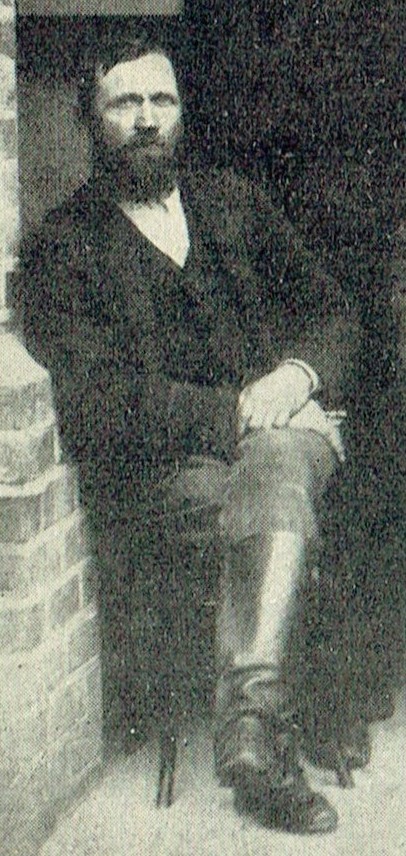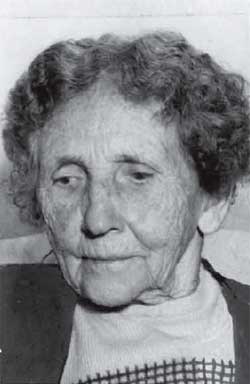Cronin
The following records were compiled by Herzl W Baker in 1978 from notes taken over a number of years during conversations with his mother-in-law Mary Ann WALTER (nee CRONIN).

Michael Cronin
Michael Cronin was a son of Patrick Cronin of Youghal, County Cork, Ireland and was born on September 4, l842. In 1854, aged 12 years, he sailed on the “Berkshire” with his parents, brother John and sisters Margaret, Mary and Ann and arrived in Fremantle in March 1855.
Michael Cronin was educated at Bishop Hale’s School in Perth, and later moved with his family to Pinjarra. He left there in 1861 for Kojonup where he worked on a farm for two years, and having gained experience, leased a farm at Mallitup (now Pallinup) where he remained for seven years.
Michael Cronin married Elinor Bridget Noonan, daughter of William Noonan, who was stationed at Kojonup as a sergeant-in-charge of the convict depot, from which the Perth-Albany road had been constructed and maintained.
In 1875 be moved to Glen Cove farm, which he had taken up from the Government two years previously, 17 miles northeast of what was later to become the town of Katanning. With him was a ticket-of-leave man, John Collins, and together they erected a slab and dab house of sheoak poles, mud walls and thatched roof of blackboy spines. It was erected as a makeshift but was to be occupied continuously until after Michael Cronin’s death on June 23, 1931 aged 88 years.
He held a freehold of 1,400 acres at Glen Cove (later shortened to Glencoe) and a pastoral lease of 20,000 acres on which he grazed sheep for wool. In the meantime, he cut many loads of sandalwood from his own land and the adjacent bush. From Glencoe, Michael Cronin carted his sandalwood and scoured wool to Perth or Albany at six monthly intervals, to whichever port offered the best price, and returned laden with stores, clothing and farm plant.
ANOTHER PIONEER PASSES
Southern Districts Advocate
6 September, 1926
By the death of Mr John Cronin, of Nippering, last week, the Great Southern loses another of its very old residents. Deceased had reached the very ripe old age of 88 years. The remains were interred in the Nippering cemetery on Friday, last.
MARRIAGE
The Sunday Times
15 November, 1936
A remarkable incident happened on of the occasion of the marriage of the late John Cronin to Miss McKenna, at the home of the late Edward Treasure, at Martinup in the early 1870’s.
The ceremony was performed by the late Bishop Gibney, assisted by the priest in charge at Albany at the time. After the wedding breakfast had been partaken of, several of the guests, (the Bishop and the bride among the number) were taken suddenly ill. A doctor had to be obtained from Albany, and he pronounced it as a case of poisoning, and prescribed accordingly.
Although no one died, it was about a week before the doctor felt justified in leaving them. On investigation it was found that the cook had inadvertently used arsenic in the preparation of the scones. Arsenic was used extensively in those days for prevention of scab in sheep, and was, in this case, with food supplies, kept on a shelf in the homestead storeroom.
PIONEER PASSES.
Death of Mr. M. Cronin.
West Australian
25 June, 1931
KATANNING, June 24. – One of the pioneers of the Katanning district, Mr. Michael Cronin, J.P., passed away at his homestead, Glencoe, yesterday morning, aged 89. He came to Kojonup in 1861 and, after gaining two years’ experience at farming, took up land at Pallinup which was relinquished in 1875 for his present holding, 18 miles from Katanning.
He was appointed a Justice of the Peace by the Daglish Government, and for ten years served as a member of the Katanning Road Board, having been the first mover in the petition to secure a local governing body. He was also a foundation member of the Katanning Agricultural Society and the Katanning Racing Club.
At the time of the Coolgardie gold rush Mr. Cronin was one of the first to blaze a trail across country to the scene of the find, with the object of opening up a route to the field from Katanning. This, however, was not used, as the Government hastened the construction of the Great Southern railway to the district.
In 1866 he married Elinor Bridget Noonan, who died in 1885, leaving a family of five sons and five daughters. The funeral took place today, and was largely attended, the remains being laid to rest in the Roman Catholic portion of the Katanning cemetery.
In the 1870s there were four farmer settlers in the area that was later to become Katanning:
the Quartermaines of Yowangup
the Grovers of Indinup
the Haddletons of Coompatine
the Cronins of Glencoe
The town of Katanning was proclaimed in 1889 shortly after the completion of the Great Southern Railway which was opened to traffic on June 1 of that year. Michael Cronin was a foundation member of the Katanning Road Board, proclaimed in 1892, and served on it for ten years. He had earlier been gazetted as a Justice of the Peace for the Katanning Magisterial district by the Daglish Government and dispensed justice from the bench of the old Katanning Police Court.
Michael Cronin lost his wife in tragic circumstances in 1885. She was thrown from a horse-drawn trap during pregnancy and became desperately ill from internal injuries. She was moved to the Grover home, Indinup, five miles west of the present town, while her husband rode on horseback to Albany to get a doctor. The doctor was away and, when he returned to Albany, set out immediately for Indinup, but she had died before he arrived. She left a family of five sons and five daughters; William, Edwin, Mary, Agnes, Elinor, Johanna, Donald, Francis, Florence and Harry.
Mary Ann, third child and eldest daughter, then took over the management of the family at the age of 14 years. She also led a busy life shepherding sheep, minding cows, helping in paddocks and doing a variety of household chores. At various times the family employed a governess and other peoples’ children also attended classes.
Mary Ann, was born at Kojonup in 1870. Her family was then living on a farm at Mallitup which was rented from Solomon Drolfe, the first settler in the Broomehill – Eticup area. Their nearest neighbours were the Treasures of Martinup.
During wagon trips to Perth and Albany with her father they both collected flora specimens for Baron Ferdinand von Mueller, one of Australia’s celebrated botanists and founder of the Melbourne Botanical Gardens. The specimens were sent by post with a description of their habitat. The following three specimens sent were new discoveries and were endowed with the family names:
Anthrixia cromnana, a small stiff herb of the daisy family.
Trachymene croniniana, wild parsnip related to the native lace blue flower.
Cenospernium croniniae, one of the smoke bushes.
Baron Von Mueller was delighted to receive specimens and sent a small reward payment to Mary each time She educated herself by purchasing second hand books with the money, and right up to her death was an avid reader.
Mary Cronin recalled the following events in her life which left a lasting impression:
The day a new chum shepherd drove the family flock of 1,900 sheep on to what he thought was a patch of good feed. In fact, it was box poison and the next day there were 1.545 corpses and only 355 live, but very groggy jumbucks.
The pain from an abscess as big as a lemon that formed on her groin. Her father rode 40 miles to Kojonup to get a lotion, but on the way home his horse stumbled and broke his collarbone and the bottle of lotion as well. By the time he arrived back at the farm the abscess had burst.
Her first trip from the wilderness to Perth, 240 miles away. She walked most of the way behind a two-ton load of sandalwood for which her father received 17 pounds ($34). He gave her five shillings (50 cents) with which she bought a second hand copy of Sir Walter Scott’s “Ivanhoe”.
The wedding of her sister Agnes on June 1, 1889. The whole family, except two sons, travelled with the honeymoon couple on the first through train to Albany on the new Great Southern Railway. It was a family honeymoon one might say.
A reunion with her brother Donald, who served in the Tenth Light Horse in World War 1. He was a famous rough rider, horse breaker, and bushman who lived in the north-west where his name was a house-hold word.
..
Can anyone provide a better photo than the one at the top of this page?

MARY ANN WALTER (nee Cronin)
January, 1870 – 2 July, 1974

Mary Ann Walter (nee Cronin)
Mary Ann was the third child and eldest daughter of Michael and Elinor Cronin of Glencoe, Katanning. She married John Edgar Walter.
Her sisters were: Agnes (married Phillip White), Elinor (married Patrick Cantwell), Johanna (married William Kelly), and Florence (married Matthew Clancy). Her brothers were: William (married Ellen Hassell), Edwin (married Myra Cornelius), Frank (unmarried), Donald (unmarried) and Harry (married Bessie Bungert).
On September 10, 1907 Mary Cronin married John Edgar Walter at Katanning and made a home in the town where they raised a family of two daughters – Mary Edna and Joy Lorraine, and a son John Rae (known as Ray). John Edgar Walter was a departmental manager with Richardson & Co Ltd of Katanning and he died on April 2, 1937.
At the age of 85, Mary Walter still played 18 holes of golf and was vitally interested in current affairs, reading “The West Australian” from cover to cover each day. She died in Perth at the age of 104 (officially, 103) on July 2, 1974 and was buried in the Katanning Cemetery in her husband’s grave. Read more
CRONIN TIMELINE
1842
Michael Cronin was born on 4 September, l842 at Youghal, County Cork, Ireland
1854/55
Michael sailed on the “Berkshire” with his parents, brother John and sisters Margaret, Mary and Ann and arrived in Fremantle in March 1855.
1861
Michael left Perth for Kojonup where he worked on a farm for two years.
1863
Michael leased a farm at Mallitup (now Pallinup) where he remained for seven years and where he married Elinor Bridget Noonan.
1870/71
Mary Ann Cronin’s birth was registered as 1871 however she told us she was actually born in January 1870 and a year later, when her uncle was going into town (probably Kojonup or Katanning) to register the birth of his child, Michael Cronin asked him to register Mary at the same time.
At the birth registration office, Uncle was told there was a fine of five pounds for births not registered within three months, so he changed the date of Marys birth to 1871 to avoid the fine. Mary said her mother knew she was dying, so she made black dresses for her daughters to wear at her funeral.
1873
Michael took up land up from the Government at “Glen Cove Farm”.
1875
He moved to Glen Cove farm.
1885
Michael Cronin lost his wife in tragic circumstances in 1885
1889
Marriage of Agnes Cronin.
Katanning proclaimed a town
Opening of the Great Southern Railway
1892
Michael Cronin was a foundation member of the Katanning Road Board
1900
Patrick Cronin, father of Michael Cronin, died at Glencoe, Katanning, on June 3, 1900 and was buried in the Katanning cemetery.
1907
On September 10, 1907 Mary Cronin married John Edgar Walter at Katanning
1931
Michael Cronin’s died on 23 June, 1931 aged 88 and was buried with his father in the family plot in the Katanning cemetery.
Mary Edna Walter married Herzel William Baker of Katanning in 1931 and they had three children Peggy Dolores, Michael John and Terence David.
1937
Ray Walter married Catherine Keenan in 1937 and they had one son, Peter.
Joy Lorraine married Elgar Smith and they had six children: Laurie Elgar, Noel Francis, Kevin John. twins Eileen Mary and Patricia Lorraine, and Bernard Michael.
John Edgar Walter died on April 2, 1937 in Katanning
1974
Mary Ann Walter (nee Cronin) died in Perth at the age of 104 (officially, 103) on July 2, 1974
FURTHER READING
Heritage Council of Western Australia: Glencoe
ROUTE TO THE GOLDFIELDS
Both Michael Cronin and Thomas Haddleton attempted to find a route to the Yilgarn gold rush around Coolgardie. Both returned to Katanning and reported on their efforts. Read more
